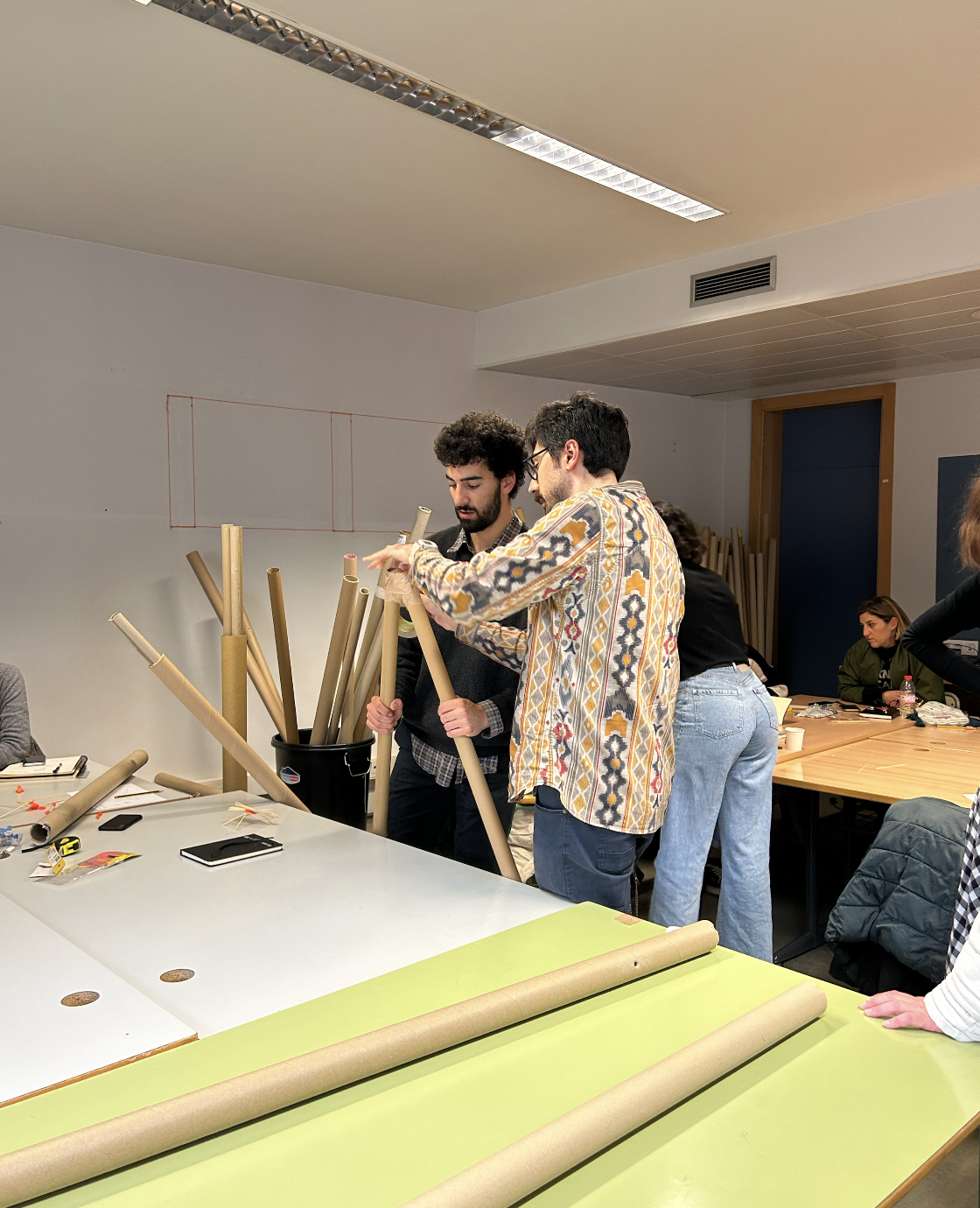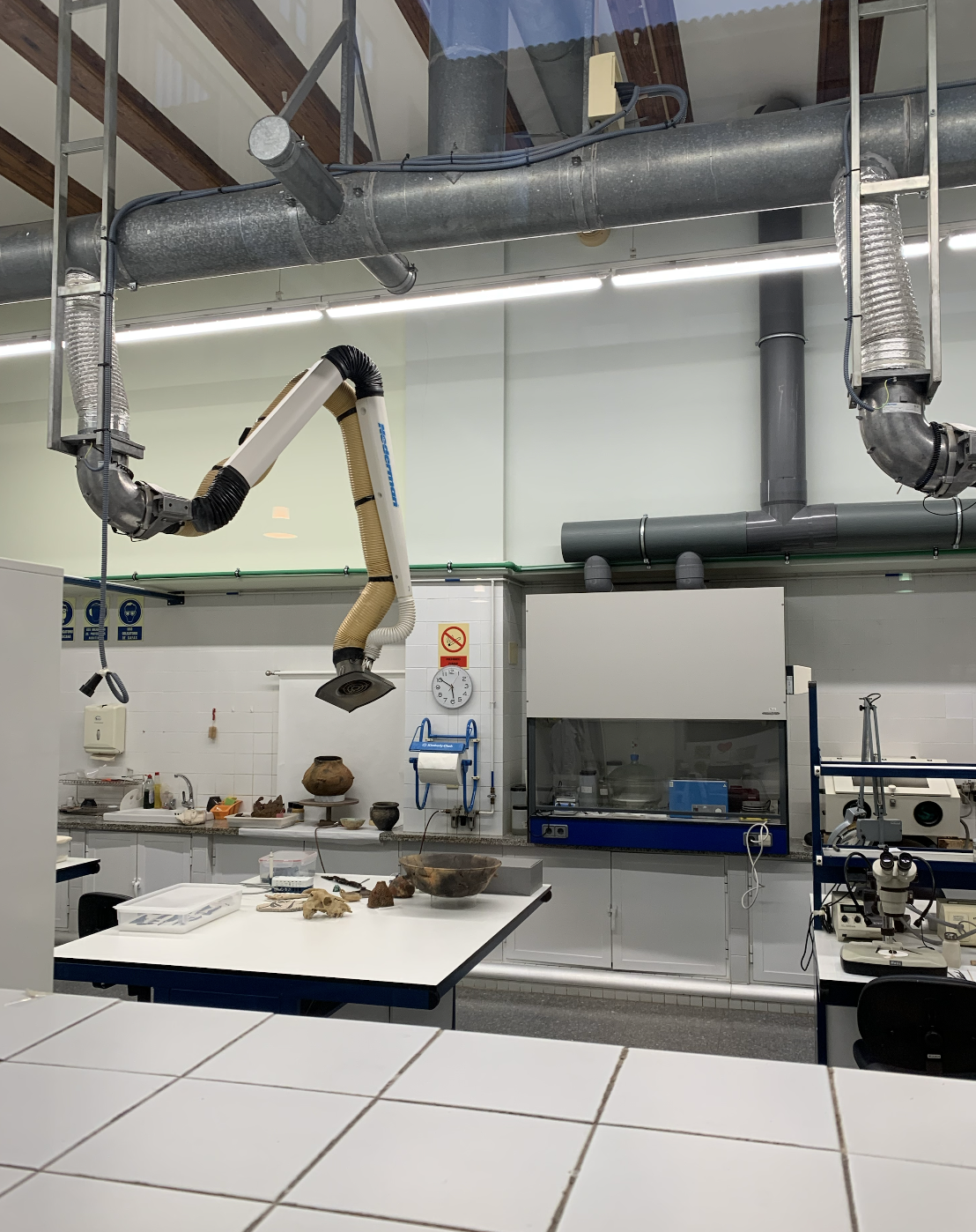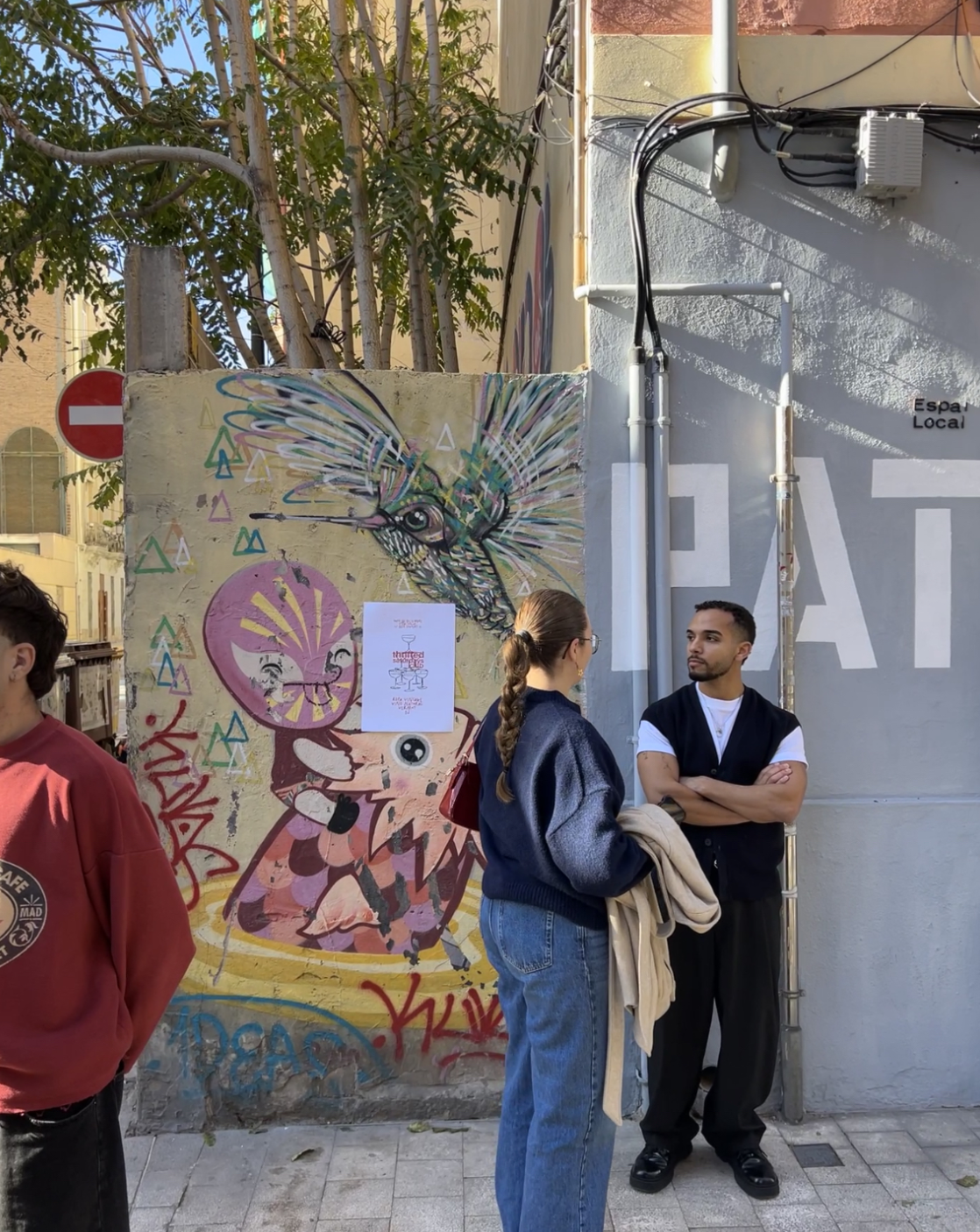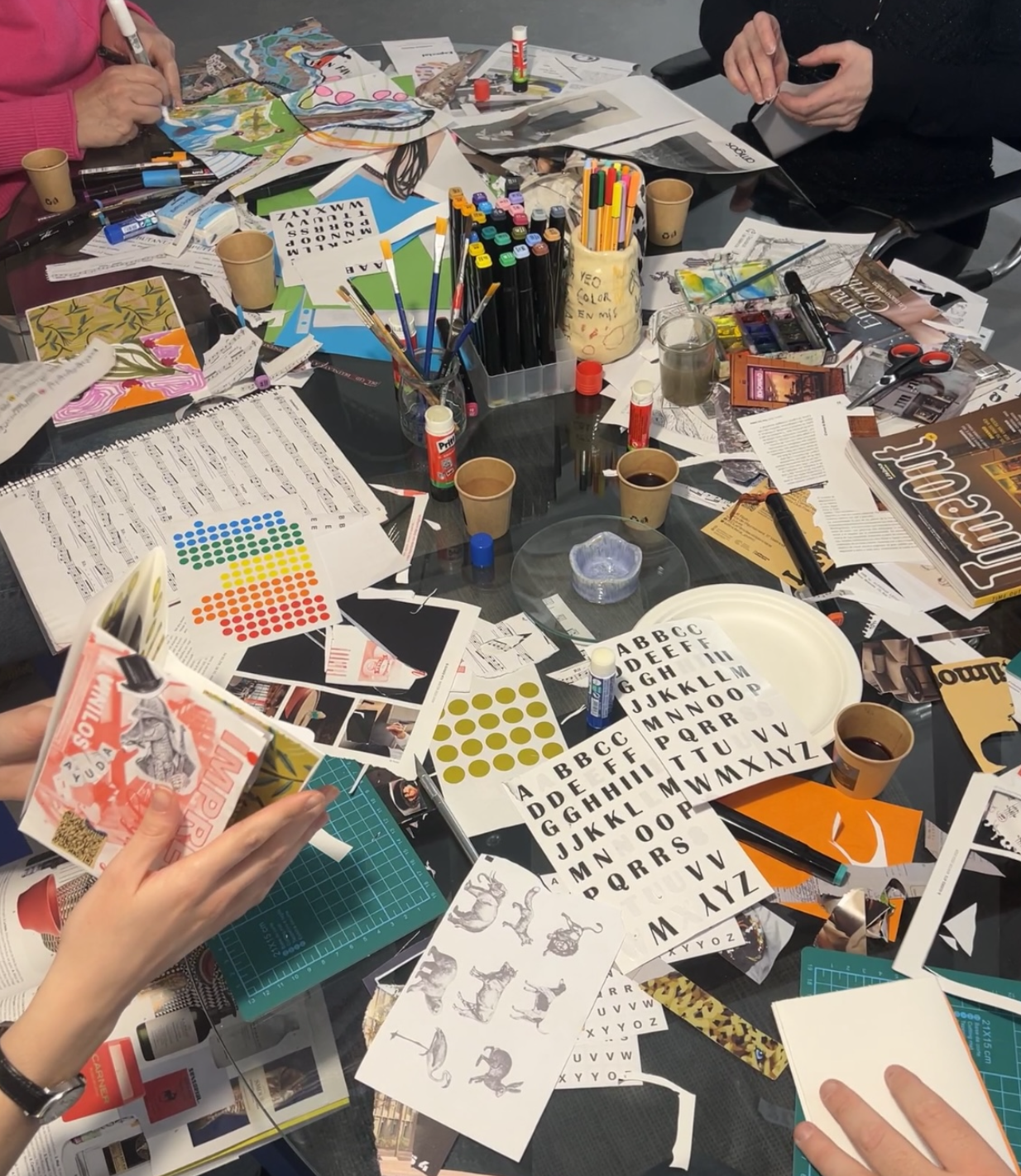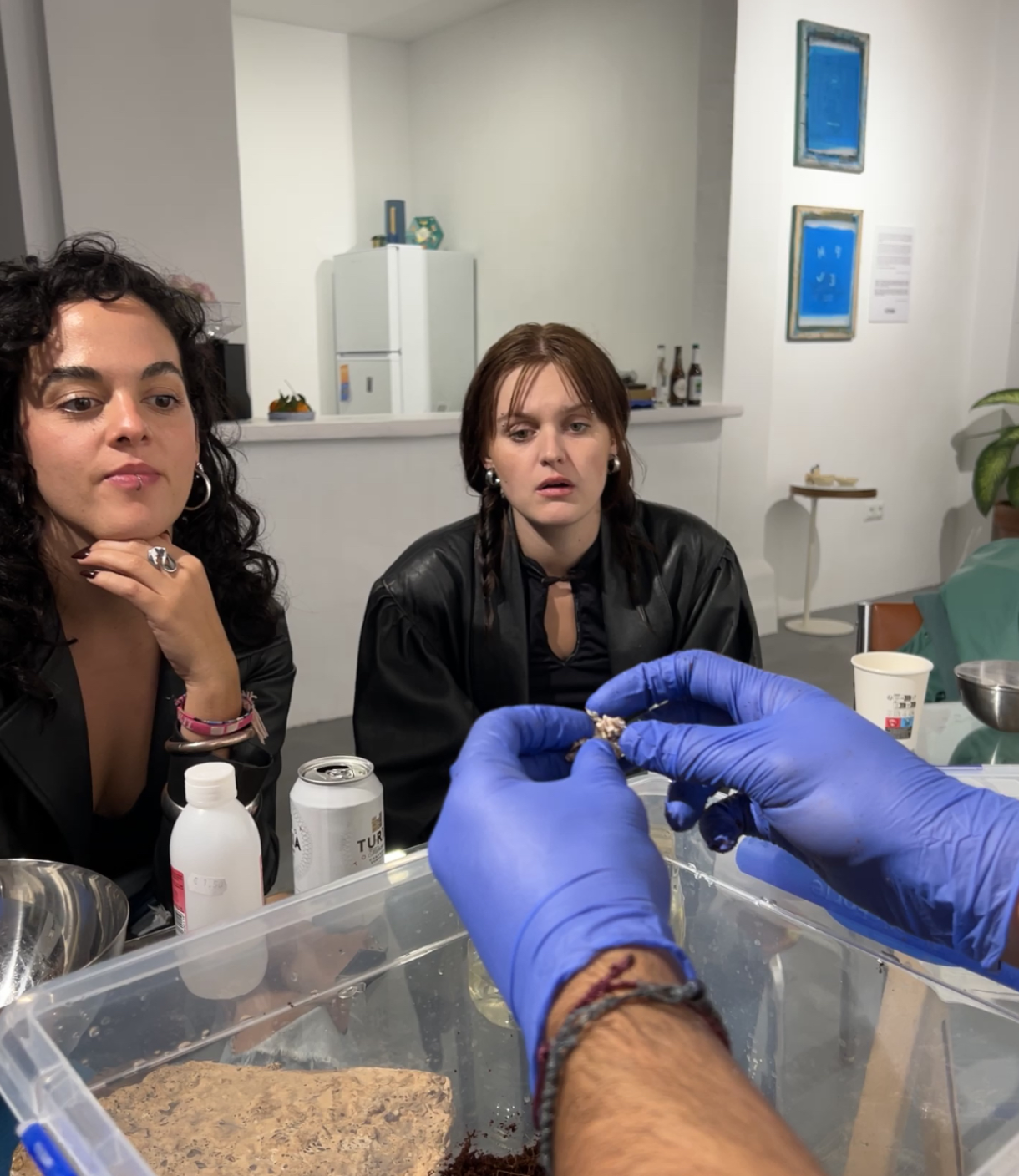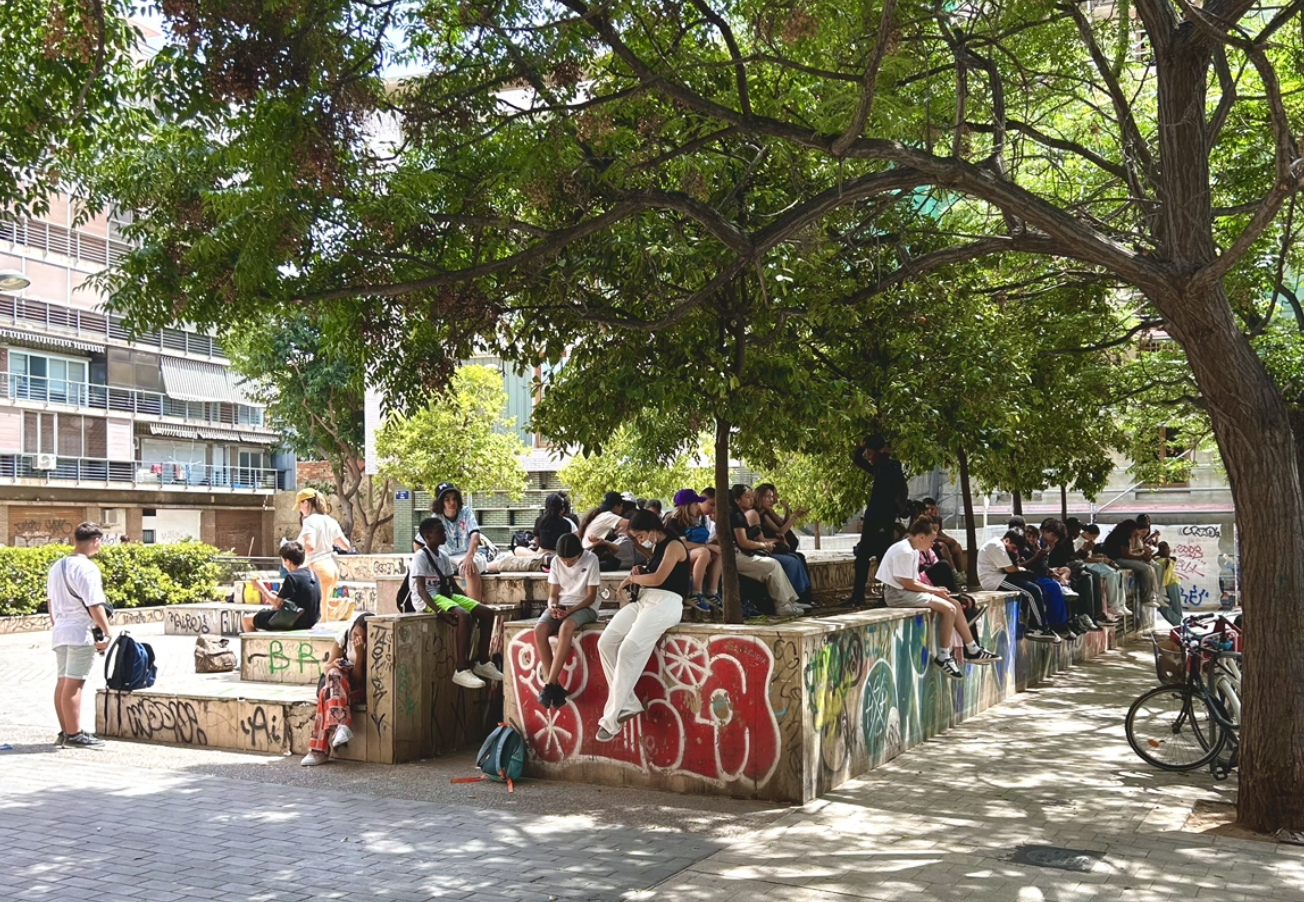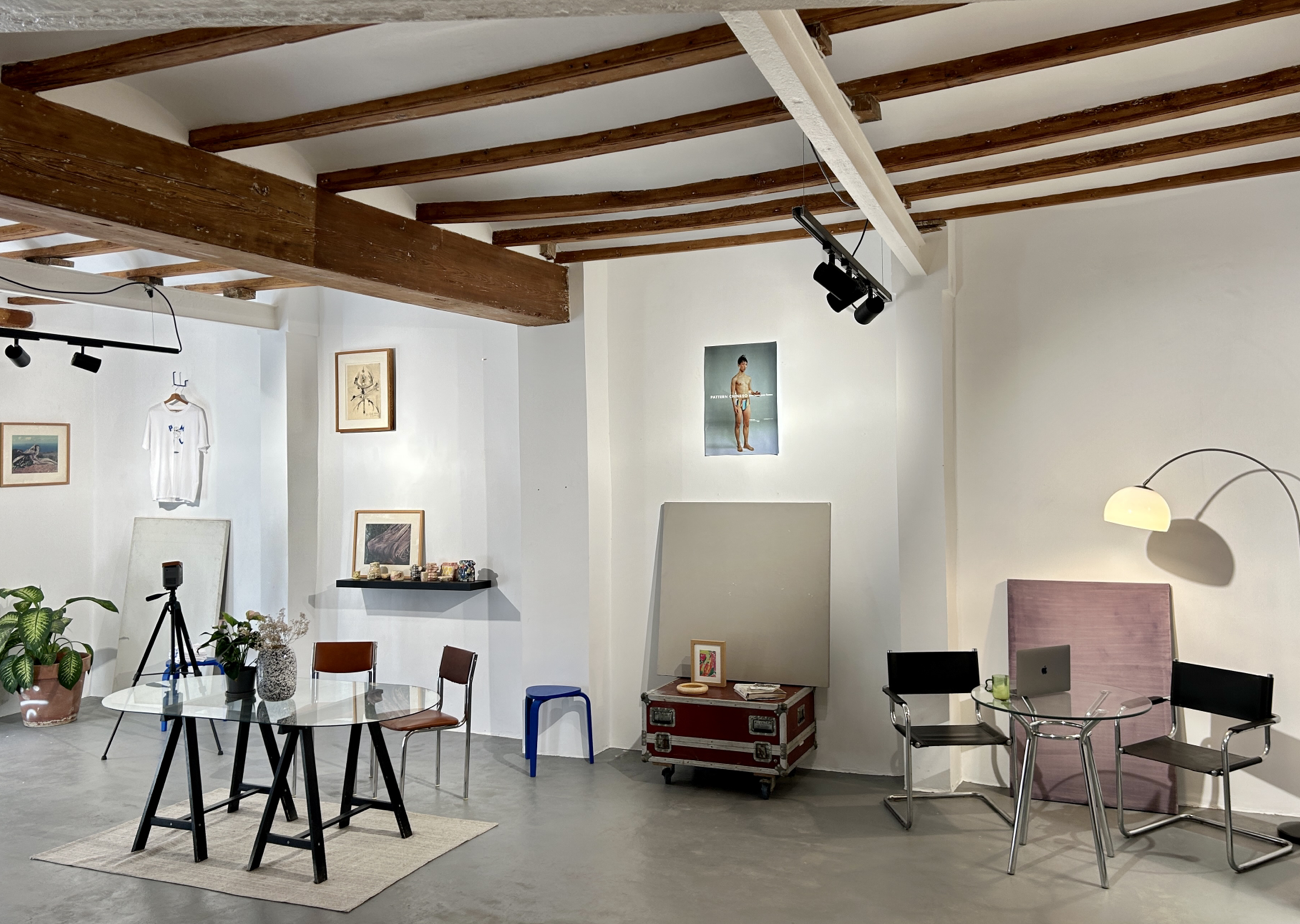Prioritising the places and people that need it the most
Espai Local: Creative Lab
Espai Local: Creative Laboratory for Urban Transformation
Espai Local is a creative laboratory where art, design, science and philosophy transform the city. Through our Creative Club and Project Incubator, we promote urban biotechnology, experimental fashion, visual and plastic arts and sound. Located next to an abandoned amphitheatre and surrounded by cultural and social centres such as the IVAM, the CCCC and the Carmen sports centre, we work to regenerate the environment and activate the community through creativity.
Spain
Local
Espai Local works in the Valencian ecosystem with FABLAB type prototyping workshops in Alboraya Oceano Naranja and Eppps point mainly, permaculture fence gardens in the orchard and cultural centres such as Nave 3, the youth centre and the library of El Carmen, as well as partnering with other associations such as Friends of El Carmen, working from the local to the global.
It addresses urban-rural linkages
It refers to other types of transformations (soft investment)
Prototype level
No
No
As a representative of an organisation
Espai Local: Creative Lab for Urban Regeneration
Espai Local is a creative laboratory that promotes urban regeneration through art, sustainability and social innovation. Located next to an abandoned amphitheatre, between the IVAM, the CCCC and the Polideportivo del Carmen, we work on the activation of the space and its surroundings through projects of urban biotechnology, experimental fashion, visual and plastic arts, and sound design. Our community has been key in the rehabilitation of the space, building furniture and providing the place with donated materials, thus promoting the circular economy and self-management.
Our aim is to provide an environment where emerging creators, neighbours and entrepreneurs can develop initiatives with social and environmental impact. Through the Creative Club, anyone can propose activities, workshops or events, while the Project Incubator offers support and tools for innovative ideas.
Objectives, Results and Impact
Regeneration of urban space: We have activated an abandoned amphitheatre and its surroundings, fostering community access to culture.
Access to fabrication tools: We have implemented a community FABLAB, enabling the development of sustainable prototypes and experimentation with materials such as mycelium and biomaterials.
Exploration in urban biotechnology: Our programmes have driven the use of living organisms and regenerative materials in design, generating new opportunities in architecture and art.
Experimental fashion and circular economy: We collaborate with emerging designers to develop sustainable garments, promoting the reuse of materials and responsible production.
Inclusive management model: The community has actively participated in the creation of furniture and structures of the space, establishing a self-managed model that can be replicated in other urban environments.
Impact on the New European Bauhaus
Espai Local demonstrates how culture and innovation can transform neighbourhoods in a susta
Espai Local is a creative laboratory that promotes urban regeneration through art, sustainability and social innovation. Located next to an abandoned amphitheatre, between the IVAM, the CCCC and the Polideportivo del Carmen, we work on the activation of the space and its surroundings through projects of urban biotechnology, experimental fashion, visual and plastic arts, and sound design. Our community has been key in the rehabilitation of the space, building furniture and providing the place with donated materials, thus promoting the circular economy and self-management.
Our aim is to provide an environment where emerging creators, neighbours and entrepreneurs can develop initiatives with social and environmental impact. Through the Creative Club, anyone can propose activities, workshops or events, while the Project Incubator offers support and tools for innovative ideas.
Objectives, Results and Impact
Regeneration of urban space: We have activated an abandoned amphitheatre and its surroundings, fostering community access to culture.
Access to fabrication tools: We have implemented a community FABLAB, enabling the development of sustainable prototypes and experimentation with materials such as mycelium and biomaterials.
Exploration in urban biotechnology: Our programmes have driven the use of living organisms and regenerative materials in design, generating new opportunities in architecture and art.
Experimental fashion and circular economy: We collaborate with emerging designers to develop sustainable garments, promoting the reuse of materials and responsible production.
Inclusive management model: The community has actively participated in the creation of furniture and structures of the space, establishing a self-managed model that can be replicated in other urban environments.
Impact on the New European Bauhaus
Espai Local demonstrates how culture and innovation can transform neighbourhoods in a susta
Creativity
Social Innovation
Sustainability
Community
Urban regeneration
Espai Local: Culture, Sustainability and Community
Espai Local is a creative laboratory where culture, sustainability and social innovation transform the city. Located next to an abandoned amphitheatre, between the IVAM, the CCCC and the Polideportivo del Carmen, we work to regenerate the urban environment through art, biotechnology and design.
Our refurbishment has been a collaborative and sustainable process, carried out by the community itself. Most of the furniture has been donated or built by our team, following principles of circular economy and self-management. This philosophy reinforces the sense of belonging and empowers those who participate in the transformation of the space.
From our Project Incubator, we promote urban biotechnology through the use of mycelium and biomaterials applied to architecture and regenerative design. In the field of experimental fashion, we collaborate with local designers in recycling and responsible production practices. We also have a sound laboratory and a plastic arts space, open to the community.
To encourage creation and experimentation, Espai Local offers access to tools and machinery through FABLAB spaces, allowing residents and collaborators to develop prototypes and innovative projects. This not only facilitates sustainable production, but also gives the community the means to bring their ideas to reality.
Our Creative Club democratises access to culture, allowing anyone to propose activities, workshops and events without economic barriers. The flexibility of the modular space optimises resources to adapt to the needs of each initiative.
More than a space, Espai Local is a replicable model of urban regeneration based on creativity and sustainable innovation. We connect people with their environment, demonstrating how art, technology and design can transform the city.
Espai Local is a creative laboratory where culture, sustainability and social innovation transform the city. Located next to an abandoned amphitheatre, between the IVAM, the CCCC and the Polideportivo del Carmen, we work to regenerate the urban environment through art, biotechnology and design.
Our refurbishment has been a collaborative and sustainable process, carried out by the community itself. Most of the furniture has been donated or built by our team, following principles of circular economy and self-management. This philosophy reinforces the sense of belonging and empowers those who participate in the transformation of the space.
From our Project Incubator, we promote urban biotechnology through the use of mycelium and biomaterials applied to architecture and regenerative design. In the field of experimental fashion, we collaborate with local designers in recycling and responsible production practices. We also have a sound laboratory and a plastic arts space, open to the community.
To encourage creation and experimentation, Espai Local offers access to tools and machinery through FABLAB spaces, allowing residents and collaborators to develop prototypes and innovative projects. This not only facilitates sustainable production, but also gives the community the means to bring their ideas to reality.
Our Creative Club democratises access to culture, allowing anyone to propose activities, workshops and events without economic barriers. The flexibility of the modular space optimises resources to adapt to the needs of each initiative.
More than a space, Espai Local is a replicable model of urban regeneration based on creativity and sustainable innovation. We connect people with their environment, demonstrating how art, technology and design can transform the city.
Espai Local is a creative laboratory for urban regeneration whose main objective is to transform the aesthetic and cultural experience of the city. We believe that design and art have the power to revitalise spaces, bring cultural value and create meaningful experiences that elevate people's quality of life. Through artistic interventions, innovative design and self-management processes, we have turned an abandoned amphitheatre into a hub of creativity and culture.
Our project is based on three essential pillars: aesthetics, experience and cultural quality. First, we have intervened the physical space with furniture built and donated by the community, reflecting an adaptable and avant-garde design that harmonises the urban with the natural. Every corner has been designed to inspire creativity and foster a sense of belonging.
Secondly, through activities, workshops and events, Espai Local becomes a catalyst for enriching experiences. Collaborations with renowned cultural institutions such as the IVAM and the CCCC, together with alliances with universities, neighbouring associations and research centres, have allowed us to organise exhibitions, conferences and participatory dynamics that invite reflection and interaction, generating an inclusive and stimulating environment for all audiences.
Finally, our commitment to cultural quality is reflected in our support for the diversity of artistic expression and the promotion of emerging creators. With programmes covering urban biotechnology, experimental fashion, visual arts and sound design, we not only promote innovation.
Overall, Espai Local stands as an example of how design and culture can regenerate urban environments, offering aesthetic benefits and high quality experiences that enrich community life. This model, based on creativity, collaboration and innovation, is replicable and serves as an inspiration for future projects within the framework of the New European Bauhaus.
Our project is based on three essential pillars: aesthetics, experience and cultural quality. First, we have intervened the physical space with furniture built and donated by the community, reflecting an adaptable and avant-garde design that harmonises the urban with the natural. Every corner has been designed to inspire creativity and foster a sense of belonging.
Secondly, through activities, workshops and events, Espai Local becomes a catalyst for enriching experiences. Collaborations with renowned cultural institutions such as the IVAM and the CCCC, together with alliances with universities, neighbouring associations and research centres, have allowed us to organise exhibitions, conferences and participatory dynamics that invite reflection and interaction, generating an inclusive and stimulating environment for all audiences.
Finally, our commitment to cultural quality is reflected in our support for the diversity of artistic expression and the promotion of emerging creators. With programmes covering urban biotechnology, experimental fashion, visual arts and sound design, we not only promote innovation.
Overall, Espai Local stands as an example of how design and culture can regenerate urban environments, offering aesthetic benefits and high quality experiences that enrich community life. This model, based on creativity, collaboration and innovation, is replicable and serves as an inspiration for future projects within the framework of the New European Bauhaus.
Espai Local is a creative laboratory committed to inclusion in all its aspects. Our project pursues key objectives that guarantee accessibility and affordability for all, the adoption of inclusive governance systems, and universal design in every intervention. Since its inception, we have worked to remove barriers, ensuring that both the physical space and the programmed activities are accessible to people of all ages and abilities.
Firstly, we promote accessibility and affordability: Espai Local offers free, open spaces for participation in cultural activities, workshops and events, complemented by token fees for those who wish to become more actively involved. This policy allows the community, regardless of socio-economic status, to access culture and innovation.
Secondly, we have put in place an inclusive governance model. Through the Creative Club, all voices have a place in decision-making, promoting a horizontal system in which emerging creators, neighbours and professionals collaborate in the definition and management of programming. This structure encourages co-creation and collective empowerment, essential elements for the construction of new social models.
Finally, we apply design-for-all principles to each project, ensuring that our urban and cultural interventions respond to the needs of a diverse community. Through strategic alliances with local institutions and neighbourhood associations, we have incorporated universal design practices that allow the environment to adapt to functional and cultural diversity.
Overall, Espai Local is an example of how creativity can be a driver of social transformation, integrating inclusion, accessibility and active participation. This model not only enriches the cultural experience, but also lays the foundations for a new paradigm of an inclusive and sustainable city, aligned with the aspirations of the New European Bauhaus.
Firstly, we promote accessibility and affordability: Espai Local offers free, open spaces for participation in cultural activities, workshops and events, complemented by token fees for those who wish to become more actively involved. This policy allows the community, regardless of socio-economic status, to access culture and innovation.
Secondly, we have put in place an inclusive governance model. Through the Creative Club, all voices have a place in decision-making, promoting a horizontal system in which emerging creators, neighbours and professionals collaborate in the definition and management of programming. This structure encourages co-creation and collective empowerment, essential elements for the construction of new social models.
Finally, we apply design-for-all principles to each project, ensuring that our urban and cultural interventions respond to the needs of a diverse community. Through strategic alliances with local institutions and neighbourhood associations, we have incorporated universal design practices that allow the environment to adapt to functional and cultural diversity.
Overall, Espai Local is an example of how creativity can be a driver of social transformation, integrating inclusion, accessibility and active participation. This model not only enriches the cultural experience, but also lays the foundations for a new paradigm of an inclusive and sustainable city, aligned with the aspirations of the New European Bauhaus.
At Espai Local, citizens and civil society are the driving force behind our project. From the very beginning, we established participatory mechanisms to ensure every voice was heard—from initial planning and idea selection to implementation and evaluation. Local residents actively participated in co-design workshops and brainstorming sessions, sharing their visions for transforming our urban space. Their invaluable feedback shaped key decisions, including the repurposing of an abandoned amphitheatre and the design of accessible community areas.
Civil society organizations and local associations, such as Amics del Carmen and youth centers, have been integral partners. They have collaborated in organizing cultural events, workshops, and community initiatives, contributing resources and expertise that have enriched our project's scope. This close involvement has transformed community members from passive beneficiaries into active co-creators, fostering a strong sense of ownership and empowerment.
The impact of this collective engagement is profound. Our project not only enhances the cultural and social vibrancy of our neighborhood but also serves as a model of participatory urban regeneration. By embedding citizen involvement at every level, Espai Local has established a sustainable, inclusive framework that demonstrates how collaborative innovation can drive meaningful change in urban environments.
Civil society organizations and local associations, such as Amics del Carmen and youth centers, have been integral partners. They have collaborated in organizing cultural events, workshops, and community initiatives, contributing resources and expertise that have enriched our project's scope. This close involvement has transformed community members from passive beneficiaries into active co-creators, fostering a strong sense of ownership and empowerment.
The impact of this collective engagement is profound. Our project not only enhances the cultural and social vibrancy of our neighborhood but also serves as a model of participatory urban regeneration. By embedding citizen involvement at every level, Espai Local has established a sustainable, inclusive framework that demonstrates how collaborative innovation can drive meaningful change in urban environments.
Local Level:
Residents, local associations (e.g., Amics del Carmen, local youth centers), and neighborhood groups played a crucial role. They participated in co-design workshops, brainstorming sessions, and decision-making meetings, ensuring the project addressed local needs and cultural priorities. Their direct involvement helped shape the transformation of our urban space and provided invaluable feedback for continuous improvement.
Regional Level:
We collaborated with regional cultural institutions such as local museums (IVAM, CCCC), cultural centers, and regional innovation hubs. These partners contributed strategic insights, expertise, and resources, aligning our activities with regional policies and facilitating connections with other regional actors. Their engagement enhanced the project’s credibility and helped integrate our initiatives into broader regional development plans.
National Level:
Key stakeholders including national cultural agencies, academic institutions, and research centers supported the project through policy advice, funding opportunities, and knowledge exchange. Their involvement ensured our project met national standards in innovation, culture, and sustainable urban regeneration, while also opening doors to national networks and resources.
European Level:
At the European level, partnerships with institutions like the European New Bauhaus and participation in EU innovation networks provided a framework of best practices and emerging trends. This engagement not only validated our approach but also positioned Espai Local as a replicable model for inclusive urban regeneration across Europe.
Added Value:
This multilevel engagement has enriched our project by incorporating diverse perspectives and fostering cross-sector collaboration. It has allowed us to leverage resources, expertise, and networks at every level, ensuring sustainability, scalability, and a lasting cultural impact on our community.
Residents, local associations (e.g., Amics del Carmen, local youth centers), and neighborhood groups played a crucial role. They participated in co-design workshops, brainstorming sessions, and decision-making meetings, ensuring the project addressed local needs and cultural priorities. Their direct involvement helped shape the transformation of our urban space and provided invaluable feedback for continuous improvement.
Regional Level:
We collaborated with regional cultural institutions such as local museums (IVAM, CCCC), cultural centers, and regional innovation hubs. These partners contributed strategic insights, expertise, and resources, aligning our activities with regional policies and facilitating connections with other regional actors. Their engagement enhanced the project’s credibility and helped integrate our initiatives into broader regional development plans.
National Level:
Key stakeholders including national cultural agencies, academic institutions, and research centers supported the project through policy advice, funding opportunities, and knowledge exchange. Their involvement ensured our project met national standards in innovation, culture, and sustainable urban regeneration, while also opening doors to national networks and resources.
European Level:
At the European level, partnerships with institutions like the European New Bauhaus and participation in EU innovation networks provided a framework of best practices and emerging trends. This engagement not only validated our approach but also positioned Espai Local as a replicable model for inclusive urban regeneration across Europe.
Added Value:
This multilevel engagement has enriched our project by incorporating diverse perspectives and fostering cross-sector collaboration. It has allowed us to leverage resources, expertise, and networks at every level, ensuring sustainability, scalability, and a lasting cultural impact on our community.
Our project design and implementation reflect a rich confluence of disciplines, including visual and plastic arts, design, sound and fashion, as well as science, technology, and urban regeneration. This multidisciplinary approach has enabled us to create a dynamic, sustainable cultural hub in an urban setting.
Visual and plastic arts provided the aesthetic foundation for transforming an abandoned amphitheatre into a vibrant space. Design and sound contributed to shaping interactive environments and experiences, while experimental fashion introduced innovative, sustainable practices through creative reuse and circular economy principles. Concurrently, science and technology, particularly in urban biotechnology and prototyping within our FABLAB, offered the technical expertise needed to integrate regenerative materials and cutting-edge methods.
Representatives from these diverse fields interacted through structured co-creation workshops, interdisciplinary brainstorming sessions, and collaborative project teams. Artists, designers, engineers, scientists, and community organizers came together to share perspectives and expertise, fostering an environment where creative expression met rigorous inquiry. Partnerships with academic institutions, such as the UPV, and research centers further enriched this dialogue, ensuring that every creative endeavor was underpinned by sound scientific and technical principles.
The added value of this process lies in its holistic nature. By merging creative and scientific approaches, we have developed solutions that are not only aesthetically appealing but also environmentally sustainable and socially inclusive. This synergy has allowed us to address local needs comprehensively, enhancing community engagement and establishing a replicable model of urban regeneration. Ultimately, Espai Local stands as a beacon of integrated innovation, where the fusion of art, design, science, and technology drives transformative cultural
Visual and plastic arts provided the aesthetic foundation for transforming an abandoned amphitheatre into a vibrant space. Design and sound contributed to shaping interactive environments and experiences, while experimental fashion introduced innovative, sustainable practices through creative reuse and circular economy principles. Concurrently, science and technology, particularly in urban biotechnology and prototyping within our FABLAB, offered the technical expertise needed to integrate regenerative materials and cutting-edge methods.
Representatives from these diverse fields interacted through structured co-creation workshops, interdisciplinary brainstorming sessions, and collaborative project teams. Artists, designers, engineers, scientists, and community organizers came together to share perspectives and expertise, fostering an environment where creative expression met rigorous inquiry. Partnerships with academic institutions, such as the UPV, and research centers further enriched this dialogue, ensuring that every creative endeavor was underpinned by sound scientific and technical principles.
The added value of this process lies in its holistic nature. By merging creative and scientific approaches, we have developed solutions that are not only aesthetically appealing but also environmentally sustainable and socially inclusive. This synergy has allowed us to address local needs comprehensively, enhancing community engagement and establishing a replicable model of urban regeneration. Ultimately, Espai Local stands as a beacon of integrated innovation, where the fusion of art, design, science, and technology drives transformative cultural
Espai Local is not just another urban regeneration project—it’s a living laboratory where creativity, sustainability, and innovation converge to redefine the urban experience. Unlike mainstream initiatives that often focus solely on architectural refurbishment or infrastructural improvements, our project integrates art, design, science, and cultural activism into a holistic approach. Located next to an abandoned amphitheatre in the heart of Valencia, Espai Local transforms neglected urban spaces into vibrant cultural hubs that inspire community engagement and social renewal.
Our innovative character lies in the multidisciplinary process that underpins every aspect of the project. We incorporate urban biotechnology—using regenerative materials like mycelium and biomaterials—into design and architectural interventions, creating living, evolving structures that are both environmentally sustainable and aesthetically striking. Experimental fashion and visual arts further enrich the project, challenging conventional norms and opening new avenues for creative expression.
Central to our approach is a strong emphasis on participatory governance and community co-creation. Unlike traditional top-down urban projects, Espai Local is built by and for the community. Residents, local associations, and emerging creators actively participate in the design, implementation, and evaluation of initiatives, ensuring that the project not only meets local needs but also empowers citizens to shape their urban environment. This inclusive model extends to our Project Incubator and FABLAB, where multidisciplinary teams work together to prototype and refine innovative solutions, supported by legal and fiscal advisory services that protect and nurture emerging ideas.
By bridging diverse fields and fostering deep local engagement, Espai Local offers a replicable model of urban regeneration that challenges conventional practices and sets a new standard for cultural and social innovation.
Our innovative character lies in the multidisciplinary process that underpins every aspect of the project. We incorporate urban biotechnology—using regenerative materials like mycelium and biomaterials—into design and architectural interventions, creating living, evolving structures that are both environmentally sustainable and aesthetically striking. Experimental fashion and visual arts further enrich the project, challenging conventional norms and opening new avenues for creative expression.
Central to our approach is a strong emphasis on participatory governance and community co-creation. Unlike traditional top-down urban projects, Espai Local is built by and for the community. Residents, local associations, and emerging creators actively participate in the design, implementation, and evaluation of initiatives, ensuring that the project not only meets local needs but also empowers citizens to shape their urban environment. This inclusive model extends to our Project Incubator and FABLAB, where multidisciplinary teams work together to prototype and refine innovative solutions, supported by legal and fiscal advisory services that protect and nurture emerging ideas.
By bridging diverse fields and fostering deep local engagement, Espai Local offers a replicable model of urban regeneration that challenges conventional practices and sets a new standard for cultural and social innovation.
At Espai Local, our approach centers on a dynamic, community-driven methodology that integrates creativity, sustainability, and interdisciplinary collaboration to drive urban regeneration. The process begins with an open call for ideas, inviting community members, local associations, and emerging creators to submit project proposals. Each proposal is evaluated based on its potential for social impact, sustainability, and innovative design. Our evaluation criteria ensure that only the most promising projects, which embody our values of inclusivity and environmental stewardship, are selected.
Once chosen, projects enter our Incubation phase, where they benefit from structured support including legal and fiscal advisory services, access to our community FABLAB and prototyping tools, and mentorship from experts in art, design, science, and technology. This phase is characterized by co-creation workshops, iterative prototyping sessions, and collaborative design meetings where diverse teams refine their concepts and transform ideas into tangible solutions.
Following this, projects are pilot-tested in our urban setting, transforming underutilized spaces into vibrant hubs of cultural and social activity. Continuous feedback from local stakeholders fuels an iterative cycle of testing, evaluation, and improvement, ensuring that each initiative adapts to real-world challenges and community needs.
Finally, successful projects are scaled up and integrated into our broader program of activities, workshops, and events. Through participatory governance, the community remains engaged at every step, fostering a sense of ownership and ensuring long-term sustainability. By bridging the gap between artistic expression and technological innovation, Espai Local not only regenerates urban spaces but also creates a replicable model of creative urban renewal that sets a new benchmark in inclusive, sustainable development.
Once chosen, projects enter our Incubation phase, where they benefit from structured support including legal and fiscal advisory services, access to our community FABLAB and prototyping tools, and mentorship from experts in art, design, science, and technology. This phase is characterized by co-creation workshops, iterative prototyping sessions, and collaborative design meetings where diverse teams refine their concepts and transform ideas into tangible solutions.
Following this, projects are pilot-tested in our urban setting, transforming underutilized spaces into vibrant hubs of cultural and social activity. Continuous feedback from local stakeholders fuels an iterative cycle of testing, evaluation, and improvement, ensuring that each initiative adapts to real-world challenges and community needs.
Finally, successful projects are scaled up and integrated into our broader program of activities, workshops, and events. Through participatory governance, the community remains engaged at every step, fostering a sense of ownership and ensuring long-term sustainability. By bridging the gap between artistic expression and technological innovation, Espai Local not only regenerates urban spaces but also creates a replicable model of creative urban renewal that sets a new benchmark in inclusive, sustainable development.
Espai Local is an urban regeneration project that integrates art, design, science and community participation to revitalise underused spaces in Valencia. Our methodology is based on community co-creation, involving local residents, associations and emerging creators in all stages of the project, from planning to implementation. This participatory approach ensures that initiatives reflect the needs and aspirations of the community, fostering a sense of ownership and empowerment.
Interdisciplinary collaboration is fundamental to Espai Local. Artists, designers, scientists and technologists work together to develop innovative and sustainable solutions. For example, we incorporate urban biotechnology and regenerative materials into our architectural interventions, creating ecological and aesthetically appealing structures. This approach can be adopted by other projects that seek to combine creativity and sustainability.
In addition, we have established a community FABLAB that provides access to prototyping tools and resources for project development. This space fosters local innovation and hands-on learning, and can be replicated in other areas to support local entrepreneurs and creators.
We promote circular economy practices, such as experimental fashion and creative reuse of materials, to reduce waste and encourage sustainability. These initiatives can be transferred to other contexts seeking to implement green practices in urban development.
Our project incubation model offers structured support to selected initiatives, including legal and fiscal advice, access to resources and mentoring. This approach can be adapted by other organisations to nurture emerging ideas and facilitate their successful implementation.
By replicating these elements, other communities can benefit from a holistic and inclusive approach to urban regeneration, promoting innovation, sustainability and active citizen participation.
Interdisciplinary collaboration is fundamental to Espai Local. Artists, designers, scientists and technologists work together to develop innovative and sustainable solutions. For example, we incorporate urban biotechnology and regenerative materials into our architectural interventions, creating ecological and aesthetically appealing structures. This approach can be adopted by other projects that seek to combine creativity and sustainability.
In addition, we have established a community FABLAB that provides access to prototyping tools and resources for project development. This space fosters local innovation and hands-on learning, and can be replicated in other areas to support local entrepreneurs and creators.
We promote circular economy practices, such as experimental fashion and creative reuse of materials, to reduce waste and encourage sustainability. These initiatives can be transferred to other contexts seeking to implement green practices in urban development.
Our project incubation model offers structured support to selected initiatives, including legal and fiscal advice, access to resources and mentoring. This approach can be adapted by other organisations to nurture emerging ideas and facilitate their successful implementation.
By replicating these elements, other communities can benefit from a holistic and inclusive approach to urban regeneration, promoting innovation, sustainability and active citizen participation.
Espai Local addresses several global challenges through localized, community-driven solutions:
1. Climate Change and Environmental Sustainability: Urban areas significantly contribute to global carbon emissions. Espai Local mitigates this by integrating urban biotechnology and regenerative materials into architectural designs, creating eco-friendly structures that reduce environmental impact. This approach aligns with global efforts to combat climate change through sustainable urban development.
2. Social Inclusion and Community Empowerment: Rapid urbanization often leads to social disparities and community fragmentation. Espai Local fosters social cohesion by involving local residents, associations, and emerging creators in all project phases. This participatory governance model empowers communities, ensuring that urban regeneration reflects their needs and aspirations, thereby addressing social inequality.
3. Economic Resilience and Innovation: Global economic volatility necessitates resilient local economies. Espai Local contributes by supporting local entrepreneurs and creators through its Project Incubator and community FABLAB. By providing resources, mentorship, and prototyping tools, the project stimulates local innovation and economic diversification, enhancing community resilience.
4. Preservation of Cultural Heritage: Globalization can erode local cultures. Espai Local combats this by integrating art, design, and cultural activism into urban spaces, celebrating and preserving Valencia's rich cultural heritage. This approach ensures that modernization efforts honor and maintain local traditions.
5. Sustainable Urban Development: Unplanned urban expansion often leads to environmental degradation. Espai Local transforms underutilized urban areas into vibrant cultural hubs, optimizing land use and reducing urban sprawl. This strategy promotes sustainable urban growth and serves as a model for other cities facing similar challenges.
1. Climate Change and Environmental Sustainability: Urban areas significantly contribute to global carbon emissions. Espai Local mitigates this by integrating urban biotechnology and regenerative materials into architectural designs, creating eco-friendly structures that reduce environmental impact. This approach aligns with global efforts to combat climate change through sustainable urban development.
2. Social Inclusion and Community Empowerment: Rapid urbanization often leads to social disparities and community fragmentation. Espai Local fosters social cohesion by involving local residents, associations, and emerging creators in all project phases. This participatory governance model empowers communities, ensuring that urban regeneration reflects their needs and aspirations, thereby addressing social inequality.
3. Economic Resilience and Innovation: Global economic volatility necessitates resilient local economies. Espai Local contributes by supporting local entrepreneurs and creators through its Project Incubator and community FABLAB. By providing resources, mentorship, and prototyping tools, the project stimulates local innovation and economic diversification, enhancing community resilience.
4. Preservation of Cultural Heritage: Globalization can erode local cultures. Espai Local combats this by integrating art, design, and cultural activism into urban spaces, celebrating and preserving Valencia's rich cultural heritage. This approach ensures that modernization efforts honor and maintain local traditions.
5. Sustainable Urban Development: Unplanned urban expansion often leads to environmental degradation. Espai Local transforms underutilized urban areas into vibrant cultural hubs, optimizing land use and reducing urban sprawl. This strategy promotes sustainable urban growth and serves as a model for other cities facing similar challenges.
Espai Local is an urban regeneration project in Valencia that addresses global challenges through local solutions. In the coming year, we plan to implement the following steps:
1. Broadening Community Participation: We will organise inclusive workshops and forums to engage a more diverse range of local residents, associations and emerging creators, ensuring that our initiatives reflect the needs and aspirations of the community.
2. Strengthening Interdisciplinary Collaboration: We will foster innovation through seminars and collaborative projects that bring together artists, designers, scientists and technologists, promoting the integration of creative and scientific approaches.
3. Enhancing Community FABLAB: We will upgrade our prototyping facilities with advanced tools and technologies, providing local entrepreneurs and makers with improved resources to develop and test their projects.
4. Promotion of Sustainable Practices: We will implement and promote sustainable practices, such as the use of regenerative materials and urban biotechnology, through educational programmes and pilot projects that demonstrate their environmental and economic benefits.
5. Scaling up the Project Incubator: We will expand our incubator programme to support more initiatives, offering additional mentoring, legal and financial advice, and facilitating access to funding sources for emerging projects.
6. Establish Strategic Partnerships: We will collaborate with local government agencies, educational institutions and private sector actors to bring additional resources, expertise and platforms to amplify the impact of our projects.
7. Launch a Comprehensive Communications Campaign: We will implement a communications strategy that uses social media, local media and community events to raise awareness and attract broader participation, highlighting success stories and opportunities for involvement.
1. Broadening Community Participation: We will organise inclusive workshops and forums to engage a more diverse range of local residents, associations and emerging creators, ensuring that our initiatives reflect the needs and aspirations of the community.
2. Strengthening Interdisciplinary Collaboration: We will foster innovation through seminars and collaborative projects that bring together artists, designers, scientists and technologists, promoting the integration of creative and scientific approaches.
3. Enhancing Community FABLAB: We will upgrade our prototyping facilities with advanced tools and technologies, providing local entrepreneurs and makers with improved resources to develop and test their projects.
4. Promotion of Sustainable Practices: We will implement and promote sustainable practices, such as the use of regenerative materials and urban biotechnology, through educational programmes and pilot projects that demonstrate their environmental and economic benefits.
5. Scaling up the Project Incubator: We will expand our incubator programme to support more initiatives, offering additional mentoring, legal and financial advice, and facilitating access to funding sources for emerging projects.
6. Establish Strategic Partnerships: We will collaborate with local government agencies, educational institutions and private sector actors to bring additional resources, expertise and platforms to amplify the impact of our projects.
7. Launch a Comprehensive Communications Campaign: We will implement a communications strategy that uses social media, local media and community events to raise awareness and attract broader participation, highlighting success stories and opportunities for involvement.

